
|

|
 | |
|
An up close and personal interview with U.S. Air Force Veteran and Togetherweserved.com Member:
Maj Henry Donaldson U.S. Air Force (Ret) (1949-1970)
PLEASE DESCRIBE WHO OR WHAT INFLUENCED YOUR DECISION TO JOIN THE AIR FORCE?
 During my final months of high school, I was wrestling with my future career path. My father had passed away the previous year. My widowed Mother was caring for my younger brother, so my options were pretty limited. College was not a possibility at that time. Guess the Marine Corps recruiting posters proved to be effective, in my case. I enlisted for a one year tour of active duty and six years of reserve service, a contract that was jokingly called: "Truman Tourist". It was my hope that during this period, I would be able to develop some career objectives as well as find a means for financing further educational opportunities. The start of the Korean War, two days preceding my active duty discharge from the Marine Corps, changed all that. During my final months of high school, I was wrestling with my future career path. My father had passed away the previous year. My widowed Mother was caring for my younger brother, so my options were pretty limited. College was not a possibility at that time. Guess the Marine Corps recruiting posters proved to be effective, in my case. I enlisted for a one year tour of active duty and six years of reserve service, a contract that was jokingly called: "Truman Tourist". It was my hope that during this period, I would be able to develop some career objectives as well as find a means for financing further educational opportunities. The start of the Korean War, two days preceding my active duty discharge from the Marine Corps, changed all that.
WHETHER YOU WERE IN THE SERVICE FOR SEVERAL YEARS OR AS A CAREER, PLEASE DESCRIBE THE DIRECTION OR PATH YOU TOOK.
My military career included one year in the Marine Corps, a few months in the Marine Corps Reserves, a couple of years as an enlisted man and aviation cadet in the Air Force, followed by 17-years as a commissioned officer. There was also the six months I spent in the Merchant Marine.
In some ways, however, it might be said that my military career started when I attended military school for nearly four years, while living in Canada. During a brief hiatus from that school I hired on as a merchant seaman on an American steamship bound for the near and far east.
During those six months, I traveled to many countries, including Palestine (Israel) where I earned combat pay due to the ongoing Arab-Jewish conflict. We passed through the Suez Canal, steamed down the Red Sea with several ports of call along the way. Next was the Persian Gulf, up the Euphrates River to Iraq and Iran. We then proceeded around the  Indian Ocean ending up at Calcutta before heading home to the USA. After several stateside stops, I disembarked in Mobile, Alabama and returned to my studies at the military school in Canada. One year later, we moved to Washington, DC where I resumed my final year of high school prior to enlistment in the Marines. Indian Ocean ending up at Calcutta before heading home to the USA. After several stateside stops, I disembarked in Mobile, Alabama and returned to my studies at the military school in Canada. One year later, we moved to Washington, DC where I resumed my final year of high school prior to enlistment in the Marines.
My year of active duty with the Marine Corps included three memorable months of boot camp at Parris Island, South Carolina, followed by a nine-month assignment as a military policeman at Patuxent Naval Air Station, Maryland. Two days before my active duty discharge, the Korean War broke out so I figured it was only a matter of time before I would be recalled to active duty. But before that could happen, my friend suggested I join the Air Force where career opportunities were greater than other branches of service. I took his advice and signed up for a four-year enlistment in the Air Force on September 21, 1950. While waiting for final processing, however, I received orders to return to active duty with the Marine Corps. Those orders were rescinded due to my enlistment. I am forever indebted to my friend for his advice to join the Air Force. Photo is of me during aviation cadet training.
There was however another draft issue I had to content with and one that had a rather humorous side. While I was in the Marine Corps Reserve, awaiting acceptance for duty with the Air Force, I was also trying to get a draft notice cancelled that had been sent to me by the 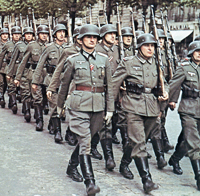 French Government. Having been born in France, I had dual citizenship with an American father and a French mother. We left France at the start of World War II when the Germans invaded France. I ended up having to 'repudiate' my French citizenship to void the possibilities of having a fugitive, draft evader warrant issued against me. My father was a U.S. Government Foreign Service Officer with the State Department. He served in France and other European posts, from 1926 until 1942. Photo is of Nazi soldiers entering Paris in June 1940. French Government. Having been born in France, I had dual citizenship with an American father and a French mother. We left France at the start of World War II when the Germans invaded France. I ended up having to 'repudiate' my French citizenship to void the possibilities of having a fugitive, draft evader warrant issued against me. My father was a U.S. Government Foreign Service Officer with the State Department. He served in France and other European posts, from 1926 until 1942. Photo is of Nazi soldiers entering Paris in June 1940.
The first place I was sent to after joining the Air Force was Lackland Air Force Base, Texas, for processing, issuance of uniforms, classification testing and all the other administrative functions. Basic training was waived in view of my already having attended Marine Corps boot camp. Based on my test results I was recommended for radar training at Tyndall AFB, Panama City, Florida but once I got there I was told I’d have to wait for a later class since all classes were full. Until a class opened, I was asked if I would like to volunteer for temporary duty performing administrative functions, recalling reserves for active duty to serve, as a part of the Korean War buildup. I accepted and was sent to Maxwell Air Force Base, Montgomery, Alabama where my career path took a very positive turn.
My commanding officer at Maxwell encouraged me to apply for flight training. I did and after countless examinations, I was accepted for aviation cadet training. Following my successful training at Ellington Air Force Base, Texas and Mather AFB, California, 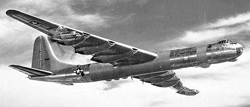 I was commission a second lieutenant and presented with the wings of a navigator. Fortunately for me, the Air Force had waived the college degree requirements as a pre-requisite for flight training since there was an increased demand for aircrews due to the Korean War. My orders were to serve as a Navigator-Bombardier aboard a B-26 and then on to Korea. Flight crew training was at Langley AFB, Virginia. I then took leave and prepared to attend survival training at Stead AFB, Nevada but before I got there, the armistice (truce) was signed on July 27, 1953. My orders were cancelled and for the second time, I avoided a tour in Korea. Instead I returned to Ellington AFB for six months of training to become a B-36 Navigator with an assignment to Fairchild AFB, Washington. I was commission a second lieutenant and presented with the wings of a navigator. Fortunately for me, the Air Force had waived the college degree requirements as a pre-requisite for flight training since there was an increased demand for aircrews due to the Korean War. My orders were to serve as a Navigator-Bombardier aboard a B-26 and then on to Korea. Flight crew training was at Langley AFB, Virginia. I then took leave and prepared to attend survival training at Stead AFB, Nevada but before I got there, the armistice (truce) was signed on July 27, 1953. My orders were cancelled and for the second time, I avoided a tour in Korea. Instead I returned to Ellington AFB for six months of training to become a B-36 Navigator with an assignment to Fairchild AFB, Washington.
I eventually became a radar navigator on an RB-36 lead crew until our unit was designated to convert to the B-52 with a move to Westover AFB, Mass., which, of course meant more training in a new radar system. It also required B-52 transition training at Castle AFB, California. Our unit was renamed the 99th Bombardment Wing (H) where I served as a navigator until acceptance for pilot training in 1958.
Pilot training was in the T-34 and T-28 at Bainbridge AFB, Georgia, advanced training in the B-25 at Reese AFB, Texas. When I completed pilot training, I applied for and obtained my (civilian) commercial pilot's license with instrument rating.
 My new assignment was as a co-pilot, flying KC-97 tankers in the 40th Air Refueling Squadron at Schilling AFB, Kansas. Over time, I was promoted to Aircraft Commander and in 1962, like many others, was selected for transition into the KC-135 with transition training taking place at Castle AFB. I was then reassigned to the 71st Air Refueling Squadron, Dow AFB Maine. My crew was ordered on a ninety-day temporary duty tour in Southeast Asia in 1966-67, as the buildup of American troops in Vietnam was in full swing. We flew refueling missions from Guam, the Philippines, Thailand and Okinawa, in support of fighter aircraft, as well as B-52's. My new assignment was as a co-pilot, flying KC-97 tankers in the 40th Air Refueling Squadron at Schilling AFB, Kansas. Over time, I was promoted to Aircraft Commander and in 1962, like many others, was selected for transition into the KC-135 with transition training taking place at Castle AFB. I was then reassigned to the 71st Air Refueling Squadron, Dow AFB Maine. My crew was ordered on a ninety-day temporary duty tour in Southeast Asia in 1966-67, as the buildup of American troops in Vietnam was in full swing. We flew refueling missions from Guam, the Philippines, Thailand and Okinawa, in support of fighter aircraft, as well as B-52's.
When my crew returned from the Southeast Asia TDY tour, I was told that I had an assignment for transition to the F-4 fighter type aircraft and subsequent assignment to Vietnam. That set of orders was canceled and replaced with orders to report for transition training as a Forward Air Controller.
I flew thirty-five hours in the T-33 and sixty-five hours in the F-100 at Luke AFB, Arizona to qualify me as a fighter pilot, a pre-requisite for Forward Air Controllers working with U.S. Army units in combat operations. The final phase took place at Hurlburt Field, Florida with extensive classroom and field exercises as well as flight training in the 0-1 single engine aircraft. Before going into Vietnam, I went through jungle survival training in the Philippines. Next stop was Tan Son Nhut Air Base, Saigon, then a helicopter ride to Bien Hoa, followed a few days later by a flight to Phan Rang for in-country training.
By now it was early March 1968. Assignments that followed began with the 21st TASS (Tactical Air Support Squadron) at Nha Trang, then Pleiku and Kontum in the Central Highlands. I flew missions in support of the 4th Infantry Division of the U.S. Army, directing air strikes, spotting for artillery, numerous other airborne assignments such as reconnaissance, convoy escort, LRRP (long range reconnaissance patrols) support.
 Subsequent assignment locations included Bong Son/ LZ English, with the 173rd Airborne Brigade; An Khe along highway 19 (street without joy fame), Dalat in the mountains north of Saigon, ending at Nha Trang, a lovely seaside town that showed its' French influence in the architecture and amenities. The end of my in country tour was as senior fighter duty officer, Direct Air Support Center Alpha (DASC-A) at First Field Forces Vietnam (IFFV). Subsequent assignment locations included Bong Son/ LZ English, with the 173rd Airborne Brigade; An Khe along highway 19 (street without joy fame), Dalat in the mountains north of Saigon, ending at Nha Trang, a lovely seaside town that showed its' French influence in the architecture and amenities. The end of my in country tour was as senior fighter duty officer, Direct Air Support Center Alpha (DASC-A) at First Field Forces Vietnam (IFFV).
I returned stateside in January 1969. My stateside assignment was with the Combat Support Group at George AFB, California. I flew the C-47, C-54, C-118 and the U-6 De Havilland 'Beaver'. I was in charge of crew standardization and evaluation as well as pilot in command of those aircraft. My air force duties ended upon retirement June 30, 1970.
DID YOU PARTICIPATE IN COMBAT OPERATIONS? IF SO, COULD YOU DESCRIBE WHICH WERE SIGNIFICANT TO YOU?
My military combat experience included five hundred seventy flying hours in two tours in the South East Asia Theater of Operations. First as a KC-135 Aircraft Commander in 1966-67. I logged close to 160 combat hours, 33 missions; twenty-one (21) refueling fighter aircraft over Laos and Cambodia, eight (8) refueling B-52 aircraft flying from Guam and/or U-Tapao, Thailand going into North and South Vietnam. I also flew three classified missions in the Gulf of Tonkin, designated 'Radio Relay'.
My next series of combat operations was in the II Corps area of South Vietnam, March 1968-January 1969, flying O-1 Bird dogs as a Forward Air Controller for more than 420 hours, 250 plus sorties.  From March until August, I lived out in the field with the army unit that I supported. Units for whom I provided air support included the 4th Infantry Division, the 173rd Airborne Brigade, the 5th Special Forces, LRRP' small number army patrols, the 1st ROK Division and the 23rd ARVN. Photo is an O-1 Birddog making a BDA (Bomb Damage Assessment). From March until August, I lived out in the field with the army unit that I supported. Units for whom I provided air support included the 4th Infantry Division, the 173rd Airborne Brigade, the 5th Special Forces, LRRP' small number army patrols, the 1st ROK Division and the 23rd ARVN. Photo is an O-1 Birddog making a BDA (Bomb Damage Assessment).
The American units I supported included; 2/503rd & 3/503rd Infantry, 1/50th and 1/69th Mechanized Units, E-17th (Desert Rats). My duties included air reconnaissance, bomb damage assessment (BDA) of B-52 air strikes. I escorted C-119 defoliation missions, verified location of long range reconnaissance patrols (LRRP's), selected targets for artillery and relayed azimuth and trajectory adjustments, I directed on target application of ordinance and 20 mm cannon fire delivered by F-100, F-4, A1E, AT-37, AC-47 (Gatling gun), AC-130 'bunker busters'. I flew highway convoy escort and  protection. On one joint US and ARVN operation, I acted as an interpreter between the French speaking South Vietnamese and the 173rd Airborne G-2 and G-3 staff. This was a joint operation south of our temporary headquarters in Dalat. One of many memorable experiences occurred when I was called on for air support by units of the 1st. Republic of Korea Division operating just north of Phu Cat Air Base. They were in a major battle with a Viet Cong unit of unknown strength. I received notice via radio that the battleship New Jersey was available offshore for artillery support. Rather a unique experience; an air force pilot, working with the navy to neutralize a battle site being engaged by foreign (Korean) allies. Photo was taken from the cockpit of the 0-1 Birddog in a flight over Vietnam. protection. On one joint US and ARVN operation, I acted as an interpreter between the French speaking South Vietnamese and the 173rd Airborne G-2 and G-3 staff. This was a joint operation south of our temporary headquarters in Dalat. One of many memorable experiences occurred when I was called on for air support by units of the 1st. Republic of Korea Division operating just north of Phu Cat Air Base. They were in a major battle with a Viet Cong unit of unknown strength. I received notice via radio that the battleship New Jersey was available offshore for artillery support. Rather a unique experience; an air force pilot, working with the navy to neutralize a battle site being engaged by foreign (Korean) allies. Photo was taken from the cockpit of the 0-1 Birddog in a flight over Vietnam.
While not attributable as personal combat experience, there are some historical events that did impact my life. When I was nine years old, living in France, the German army invaded in the spring of 1940. We were living in Le Havre, a city on the English Channel. I recall seeing German aircraft descending over the harbor, laying mines as a threat to shipping. The troops camped not far from our home, the refugees fleeing the advancing Germans, carrying their few belongings on wheelbarrows, on bicycles, whatever they could manage. We finally left in June 1940, aboard an American passenger ship headed from Genoa, Italy to New York. I recall the U-boat drills we had throughout the trip across the Mediterranean and the Atlantic.
In 1947, when I was a sixteen year old seaman anchored in the port of Haifa, the sound and  flash of gunfire was quite evident and threatening, particularly at night. I received combat pay while we anchored there. flash of gunfire was quite evident and threatening, particularly at night. I received combat pay while we anchored there.
When I received my honorable discharge from active duty in the Marine Corps, I was also given a certificate for World War II service.
As an RB-36 radar navigator, I was also responsible for the arming and deployment of nuclear weapons on assigned targets in the event of a declaration of war. As a B-52 Navigator, I was on heightened state of alert for various calamities such as, for example, the Suez Canal crisis in 1956. As a pilot in the KC-97, the Cuban Missile crisis resulted in our being placed on a heightened state of alert.
FROM YOUR ENTIRE SERVICE CAREER WHAT PARTICULAR MEMORY STANDS OUT?
My acceptance into Aviation Cadet training, which lead to a commission and the wings of a Navigator-Bombardier. These wings, I later augmented with a set of Pilot's wings and assured my career for the next twenty years.
IF YOU RECEIVED ANY MEDALS FOR VALOR OR AWARDS FOR SIGNIFICANT ACHIEVEMENT, PLEASE DESCRIBE HOW THESE WERE EARNED.
 I was awarded a Distinguished Flying Cross for a mission that occurred during my in-country field check. We were directing AT-37's, close air support (TIC-troops in contact) on a forward artillery base that was in the process of being overrun by NVA, north of Kontum, in an area called Polei Kleng. We could see the NVA cresting the hill using flame throwers . I was awarded a Distinguished Flying Cross for a mission that occurred during my in-country field check. We were directing AT-37's, close air support (TIC-troops in contact) on a forward artillery base that was in the process of being overrun by NVA, north of Kontum, in an area called Polei Kleng. We could see the NVA cresting the hill using flame throwers .
My second Distinguished Flying Cross was awarded for support of 173rd Airborne Brigade Units who were engaged in heated combat with an overwhelming North Vietnamese unit, just north of Phu Cat, west of highway 1. On that occasion, one flight of F-100's asked for confirmation that the running troops they saw below were in fact NVA before they would go in hot with their 20 mm cannon. It was unusual for the fighter aircraft to actually see what they were targeting. On that day, we had some tremendous secondary explosions.
OF ALL THE MEDALS, AWARDS, QUALIFICATION BADGES OR DEVICE YOU RECEIVED, PLEASE DESCRIBE THE ONE(S) MOST MEANINGFUL TO YOU AND WHY?
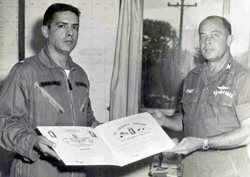 The award of my first Distinguished Flying Cross resulted from the recommendations of the army unit with whom I operated as a Forward Air Controller & Air Liaison Officer. The incident was one of the major battles that challenged the fortitude of the 173rd Airborne Brigade by a major North Vietnamese unit that had infiltrated into Bong Son Province. Using airborne, helicopter troop insertions, tanks, light armored vehicles, supporting artillery and an extensive number of airstrikes guided by our small group of FAC's, the enemy suffered major losses and a humiliating defeat. I am proud to have contributed my share to the successful outcome of this major battle, May 11, 1968. Photo is of me receiving a citation from the 173rd Airborne Brigade for my part in the battle. The award of my first Distinguished Flying Cross resulted from the recommendations of the army unit with whom I operated as a Forward Air Controller & Air Liaison Officer. The incident was one of the major battles that challenged the fortitude of the 173rd Airborne Brigade by a major North Vietnamese unit that had infiltrated into Bong Son Province. Using airborne, helicopter troop insertions, tanks, light armored vehicles, supporting artillery and an extensive number of airstrikes guided by our small group of FAC's, the enemy suffered major losses and a humiliating defeat. I am proud to have contributed my share to the successful outcome of this major battle, May 11, 1968. Photo is of me receiving a citation from the 173rd Airborne Brigade for my part in the battle.
WHICH INDIVIDUAL(S) FROM YOUR TIME IN THE MILITARY STAND OUT AS HAVING THE MOST POSITIVE IMPACT ON YOU AND WHY?
While I was on temporary duty at Maxwell Air Force Base in the fall of 1950, spring of 1951, my commanding officer encouraged me to strive for bigger and better opportunities. He was the man most responsible for my accomplishments in my twenty years in the Air Force. Lacking a college degree, I was still able to successfully complete very complex training in navigation, leading to my commission and aviation wings.
My Wing Commander, Colonel J. L. Flanagan, 397th Bombardment Wing (H) (SAC), was a significant contributor toward salvaging my career in 1965. I had been passed over for promotion to Major. He made arrangements for me to review my promotion file and make further inquiries which resulted in my successfully receiving my promotion the following year. Otherwise, my career might have ended five years early.
WHAT PROFESSION DID YOU FOLLOW AFTER YOUR MILITARY SERVICE AND WHAT ARE YOU DOING NOW? IF YOU ARE CURRENTLY SERVING, WHAT IS YOUR PRESENT OCCUPATIONAL SPECIALTY?
After retirement from the Air Force, I obtained GI Bill support to first obtain an airline transport pilot's license with the object of gaining employment with the airlines or the FAA. While seeking employment opportunities, I enrolled in a local institute of higher learning to add to the college credits  I had been slowly accumulating as the opportunity arose while in the service. Six months after retirement, I obtained employment with the State of Florida, Department of Transportation. While working in the Aviation Bureau, inspecting and licensing airports, I continued my education. In December 1979, I received a Bachelor of Science Degree from Florida State University. That was about twenty-six years later than I would have liked but it was nice to put another check mark on the list of goals and objectives I had set out for myself. I had been slowly accumulating as the opportunity arose while in the service. Six months after retirement, I obtained employment with the State of Florida, Department of Transportation. While working in the Aviation Bureau, inspecting and licensing airports, I continued my education. In December 1979, I received a Bachelor of Science Degree from Florida State University. That was about twenty-six years later than I would have liked but it was nice to put another check mark on the list of goals and objectives I had set out for myself.
I worked in the Department of Transportation for twenty plus years, in more than three specialty areas including: aviation, right of way acquisition for interstate highway construction and public transportation development. I wrote grant applications and 'lobbied' federal agencies to fund state programs and projects under my jurisdiction. I was able to obtain millions of dollars in federal funds for the State of Florida. I wrote technical specifications, prepared the bids, awarded contracts and inspected the manufacturing progress of transit buses, as well as handicap accessible vehicles, destined for service throughout the state. I retired in October 1991. Since then, I have enjoyed extensive travel to numerous states and foreign countries. I made three return visits to the country of my birth. Along the way, my wife and loving companion cajoled me into taking up golf. That has been an experience!
WHAT MILITARY ASSOCIATIONS ARE YOU A MEMBER OF, IF ANY? WHAT SPECIFIC BENEFITS DO YOU DERIVE FROM YOUR MEMBERSHIPS?
 I am a member of the 40th Bomb Wing Association as a former member of the 40th Air Refueling Squadron. I am also a member of the Forward Air Controllers Association which was established in 2000. I am a member of the 40th Bomb Wing Association as a former member of the 40th Air Refueling Squadron. I am also a member of the Forward Air Controllers Association which was established in 2000.
IN WHAT WAYS HAS SERVING IN THE MILITARY INFLUENCED THE WAY YOU HAVE APPROACHED YOUR LIFE AND YOUR CAREER?
Looking back over the past seventy some years, it would be naive to think that the twenty-one years spent in the service of my country had little impact on the balance of my life. Maturity, decision making and precise planning all were learned and developed in my military career and served me well in my subsequent career in transportation and in my personal life, in retirement.
BASED ON YOUR OWN EXPERIENCES, WHAT ADVICE WOULD YOU GIVE TO THOSE WHO HAVE RECENTLY JOINED THE AIR FORCE?
 There are many opportunities for advancement out there and young people should make a conscientious effort to perform at their maximum capability and seek recognition for their efforts. There are many opportunities for advancement out there and young people should make a conscientious effort to perform at their maximum capability and seek recognition for their efforts.
IN WHAT WAYS HAS TOGETHERWESERVED.COM HELPED YOU REMEMBER YOUR MILITARY SERVICE AND THE FRIENDS YOU SERVED WITH.
I am on my fifth year of TWS membership. Putting my military experience on paper to upload to my profile was an interesting experience. I reviewed several postings to give me some ideas on how to proceed. As I rummaged through all the layers of the TWS site, I found more and more tidbits that interested me. The 'forums', 'sitreps' and individual profiles made some great reading. Although I have not yet run into anyone with whom I have previously served, there have been a lot of familiar names. I am constantly checking the 'online' list, checking for a familiar name.
|
|
|
Share this Voices Edition on:
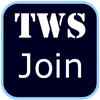
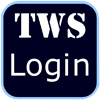

 |
|
TWS VOICES
TWS Voices are the personal stories of men and women who served in the US Military and convey how serving their Country has made a positive impact on their lives. If you would like to participate in a future edition of Voices, or know someone who might be interested, please contact TWS Voices HERE.
This edition of Air Force Voices was supported by:
AirForce.Togetherweserved.com
For current and former serving Members of the United States Air Force, Army Air Corps, Air Force Reserve and Air National Guard TogetherWeServed is a unique, feature-rich resource helping Airmen reconnect with lost Wingmen, share memories and tell their Air Force story.
To join AirForce.Togetherweserved.com, please click HERE.
|
|